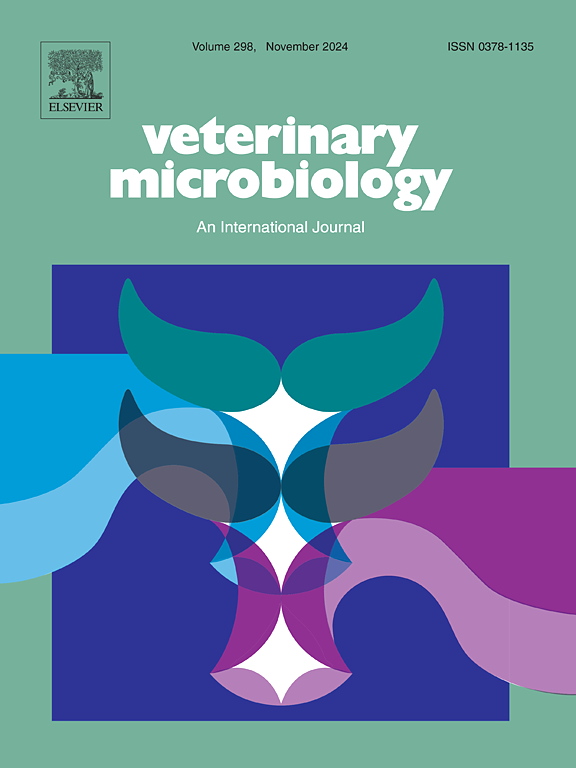Pathogenicity comparison between porcine G9P[23] and G5P[23] RVA in piglets
IF 2.4
2区 农林科学
Q3 MICROBIOLOGY
引用次数: 0
Abstract
Rotavirus Group A (RVA) is a primary pathogen that causes viral diarrhea in humans and animals. Porcine rotaviruses (PoRVs) are widely epidemic in pig farms in China, causing great economic losses to the swine industry. In the past 30 years, the G5 RVA had been the main epidemic genotype in pig farms worldwide. However, G9 RVA is an emerging genotype that is gradually becoming prevalent in humans and animals. To explore its potential mechanism, we isolated G9P[23] and G5P[23] rotaviruses, named 923 H and NG523 respectively, from diarrheal samples and compared the growth curves and virulence of two strains. In vitro experiments revealed that pig small intestine epithelial cells were more susceptible to 923 H strain. In vivo experiments showed that 923 H strain was more virulent than NG523 strain, causing more severe damage to piglets. The viral load of G9 infection groups in intestinal and extra-intestinal tissues was higher than that of G5 infection group. Histopathological examination showed cell degeneration, necrosis and nuclear condensation in the jejunum of G9 RVA infection group as well as more inflammatory cell infiltration and tissue destruction in the lung of G9 RVA infection group. Our results indicate that 923 H strain is more pathogenic than NG523 strain, which provides new insights into the widespread epidemic of G9 RVA in pig farms.
猪G9P[23]和G5P[23] RVA对仔猪致病性的比较。
轮状病毒A群(RVA)是引起人类和动物病毒性腹泻的主要病原体。猪轮状病毒(porv)在中国养猪场广泛流行,给养猪业造成巨大的经济损失。在过去30年中,G5 RVA是世界范围内猪场的主要流行基因型。然而,G9 RVA是一种新兴的基因型,在人类和动物中逐渐流行。为了探索其潜在的机制,我们从腹泻样本中分离G9P[23]和G5P[23]轮状病毒,分别命名为923 H和NG523,并比较了两株病毒的生长曲线和毒力。体外实验表明,猪小肠上皮细胞对923 H菌株更敏感。体内实验表明,923 H株毒力高于NG523株,对仔猪的伤害更为严重。G9感染组肠道和肠外组织病毒载量均高于G5感染组。组织病理学检查显示,G9 RVA感染组空肠细胞变性、坏死、核凝结,肺部炎症细胞浸润增多,组织破坏明显。结果表明,923 H菌株致病性高于NG523菌株,为G9 RVA在猪场的广泛流行提供了新的认识。
本文章由计算机程序翻译,如有差异,请以英文原文为准。
求助全文
约1分钟内获得全文
求助全文
来源期刊

Veterinary microbiology
农林科学-兽医学
CiteScore
5.90
自引率
6.10%
发文量
221
审稿时长
52 days
期刊介绍:
Veterinary Microbiology is concerned with microbial (bacterial, fungal, viral) diseases of domesticated vertebrate animals (livestock, companion animals, fur-bearing animals, game, poultry, fish) that supply food, other useful products or companionship. In addition, Microbial diseases of wild animals living in captivity, or as members of the feral fauna will also be considered if the infections are of interest because of their interrelation with humans (zoonoses) and/or domestic animals. Studies of antimicrobial resistance are also included, provided that the results represent a substantial advance in knowledge. Authors are strongly encouraged to read - prior to submission - the Editorials (''Scope or cope'' and ''Scope or cope II'') published previously in the journal. The Editors reserve the right to suggest submission to another journal for those papers which they feel would be more appropriate for consideration by that journal.
Original research papers of high quality and novelty on aspects of control, host response, molecular biology, pathogenesis, prevention, and treatment of microbial diseases of animals are published. Papers dealing primarily with immunology, epidemiology, molecular biology and antiviral or microbial agents will only be considered if they demonstrate a clear impact on a disease. Papers focusing solely on diagnostic techniques (such as another PCR protocol or ELISA) will not be published - focus should be on a microorganism and not on a particular technique. Papers only reporting microbial sequences, transcriptomics data, or proteomics data will not be considered unless the results represent a substantial advance in knowledge.
Drug trial papers will be considered if they have general application or significance. Papers on the identification of microorganisms will also be considered, but detailed taxonomic studies do not fall within the scope of the journal. Case reports will not be published, unless they have general application or contain novel aspects. Papers of geographically limited interest, which repeat what had been established elsewhere will not be considered. The readership of the journal is global.
 求助内容:
求助内容: 应助结果提醒方式:
应助结果提醒方式:


